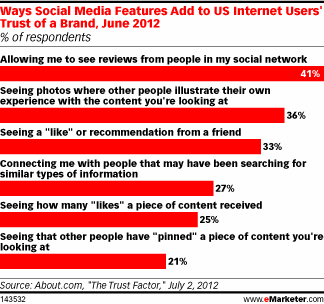Gaining consumer trust is an important issue for marketers seeking to ensure that they’re not scaring prospective customers away. In fact, a March to June survey of US adults conducted by About.com found that 84% of respondents felt that brands needed to prove themselves trustworthy before they would interact with them or other information sources. Moreover, the study found that there were 10 primary trust “elements,” or cues, that brands must establish in order to engender trust, including accuracy, expertise and transparency.
In a social media context, customers wanted to see that brands had a significant number of positive reviews, and that they didn’t go out of their way to hide the negative ones. The survey found that 41% of respondents said the ability to see reviews on social networks added to their feeling of trust in a brand. Reviews played a bigger role in cultivating trust than seeing that friends had “liked” or recommended a brand, or that the brand had accumulated a large tally of “likes.”
Video was found to improve trust the most when it served as a complement to other types of content. This ties back in to consumers’ hunger for useful information. Brands can build trust with potential customers by demonstrating expertise through quality owned content that is also devoid of a hard sales message.

